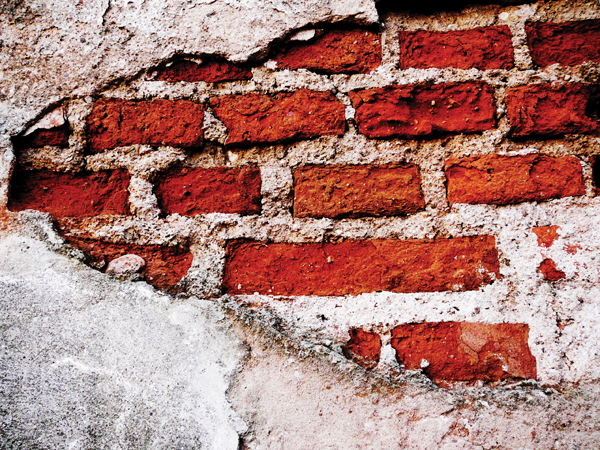 The alkalinity of the plaster is due to the presence of calcium hydroxide in it (lime lye). The decisive factor here is the water-soluble calcium hydroxide content.
The alkalinity of the plaster is due to the presence of calcium hydroxide in it (lime lye). The decisive factor here is the water-soluble calcium hydroxide content.
What damage may occur then, when the outer shell is less permeable to water vapor, than masonry and plaster?
The coating may peel off. In highly intumescent coatings, e.g. dispersion paints, blistering is also possible.
A brick wall of thick brick 24 cm is covered with a 2 cm layer of plaster. You need to put a layer of synthetic plaster on it 3 mm. Please calculate, whether the primary plaster may be damaged due to the diffusion of water vapor. The diffusion resistance of the primer layer can be neglected.
Diffusion resistance values of individual materials:
Brick: 10
Mineral plaster: 11
Synthetic plaster: 300
Calculation of the diffusion resistance for individual layers of the partition (sd)
Diffusion resistance = diffusion coefficient x layer thickness, w m.
Diffusion resistance of a brick wall = 10 • 0,24 m = 2,40 m.
Mineral plaster diffusion resistance = 11 • 0,02 m = 0,22 m.
Diffusion resistance of synthetic plaster – 300 • 0,003 m = 0,90 m.
Synthetic plaster has a lower water vapor diffusion resistance than brick masonry. Means, that water vapor penetrating through the brick wall also passes through the layer of synthetic plaster. No damage due to water vapor diffusion is therefore to be expected.
By carrying out maintenance on the facade of the building, cracks of a dynamic nature were found. What could be the causes of these scratches?? Formation of the so-called. dynamic cracks in a structure are usually due to construction errors, e.g. due to the lack of expansion joints, but also from movements or vibrations of the ground.
Every scratch, not only hairline, arises as a result of contraction.
Possible causes of crack formation in the joints. Such scratches are formed, when:
1) badly laid bricks shrink;
2) large joints between bricks are not filled;
3) primer for plaster, e.g. light wood wool boards, they are not fitted properly, and their connectors are not adequately reinforced;
4) too few layers of plaster have been applied (this is especially true for smooth plasters).
Hairline scratches form in the plaster then, when:
1) the plaster was applied in too thick layers;
2) the plaster was applied on a damp base;
3) the mortar contained too much water;
4) the plaster was rubbed too hard, as a result, the water content of its surface layer increased;
5) the plaster dried too quickly.
On new plaster to be painted, mesh nyses appear on large surfaces. What could be the reasons for this?
Mesh cracks are caused by differences in stresses between the individual layers of plaster. Stress differences arise in turn as a result of:
1) applying plasters with a high binder content on plasters with a low binder content;
2) the use of aggregate with incorrect grain size;
3) the use of unsuitable additives or in excessive amounts;
4) processing of gypsum mortars, once these have tied up.
Otherwise, the content of clay particles in the sand added to the mortar may result in the formation of strange-shaped cracks.
The reasons for the insufficient strength of the plaster may be as follows:
1) the mortar contains too little binder;
2) the plaster dried too quickly, not having enough carbon dioxide, necessary for hardening (it happens so, when plastering takes place in the scorching sun or when the substrate absorbs the water contained in the mortar too quickly);
3) the sand in the mortar contains too much dust;
4) plaster from the Pla group mortar was covered with dispersion coatings.